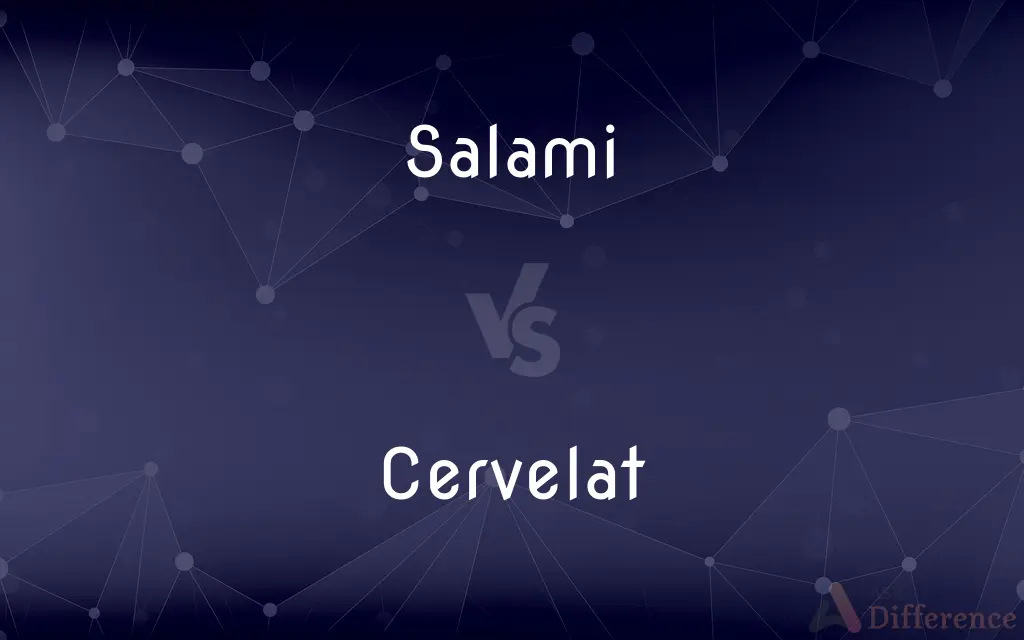Salami vs. Cervelat — What's the Difference?
By Urooj Arif & Maham Liaqat — Updated on March 8, 2024
Salami is a cured sausage known for its variety of flavors and textures, while Cervelat, a type of salami, is prized for its specific taste and Swiss origins.

Difference Between Salami and Cervelat
Table of Contents
ADVERTISEMENT
Key Differences
Salami is a term that encompasses a wide range of cured sausages originating from various European countries, each with unique spices, meats, and preparation methods. These sausages are known for their firm texture, strong flavors, and are often air-dried and fermented. On the other hand, Cervelat is a specific type of salami popular in Switzerland and parts of Germany and France. It is characterized by its fine texture, blend of beef and pork, and is typically smoked and boiled, rather than just air-dried.
Salami varieties may include ingredients such as garlic, black pepper, fennel, and wine, contributing to their distinctive flavors. These sausages can be made from a range of meats, including beef, pork, and venison, among others. Cervelat, in contrast, traditionally combines beef and pork in a specific ratio and may include spices like garlic and pepper, but it usually features a more balanced flavor profile to accommodate its role in various dishes, from salads to hot meals.
The preparation of salami involves curing the meat with salt and a mix of spices, followed by a fermentation process that can last from a few days to several months. This process not only flavors the meat but also helps preserve it. Cervelat, while also cured, typically undergoes a shorter fermentation period before being smoked and boiled, which gives it a distinctive taste and texture different from that of other salamis.
Salami is often eaten raw, thinly sliced, and can be found in sandwiches, charcuterie boards, or as part of appetizers. Its robust flavor makes it a popular choice for adding depth to various dishes. Cervelat, however, is versatile in its use, often consumed both raw and cooked. It's a staple in Swiss cuisine, appearing in everything from simple cold cuts to being grilled whole in traditional Swiss dishes.
Salami and Cervelat reflect the diversity within the world of cured meats, showcasing how regional preferences and culinary traditions influence the flavor, texture, and preparation of sausage. While salami offers a broad spectrum of tastes and styles, Cervelat provides a glimpse into the specific culinary heritage of Switzerland, making each unique in their right.
ADVERTISEMENT
Comparison Chart
Origin
Various European countries.
Switzerland, parts of Germany and France.
Ingredients
Can include beef, pork, venison, spices like garlic, pepper, fennel.
Typically a blend of beef and pork, with spices like garlic and pepper.
Texture
Varies widely, generally firm.
Fine texture, smooth.
Preparation
Air-dried and fermented, sometimes smoked.
Smoked and boiled, sometimes lightly fermented.
Usage
Eaten raw, in sandwiches, on charcuterie boards.
Versatile, eaten raw or cooked, in salads, and traditional dishes.
Compare with Definitions
Salami
Often served thinly sliced and raw.
Thinly sliced salami complements the cheese on a charcuterie board.
Cervelat
Cervelat is a Swiss sausage made from a blend of beef and pork.
Cervelat is often served sliced in Swiss salads.
Salami
Made with a mix of meats and spices.
Fennel salami offers a unique taste distinct from other varieties.
Cervelat
Typically smoked and boiled before consumption.
Smoked Cervelat adds depth to a hot pot.
Salami
Varieties can be specific to regions.
Genoa salami is softer and more finely ground than other types.
Cervelat
Can be eaten raw or cooked, showcasing its versatility.
Grilled Cervelat is a traditional Swiss dish during summer.
Salami
Salami is a variety of cured, fermented, and air-dried sausage.
Italian salami is a staple in antipasto platters.
Cervelat
Integral to Swiss cuisine, found in a variety of dishes.
Cervelat is the key ingredient in the traditional Swiss wurstsalat.
Salami
Known for its strong flavor and firm texture.
Peppered salami adds a spicy kick to sandwiches.
Cervelat
Characterized by its fine texture and balanced flavor.
The smooth texture of Cervelat makes it a favorite in cold cuts.
Salami
A large cured meat sausage of Italian origin, served in slices.
Cervelat
Cervelat, also cervelas, servelat or zervelat, is a sausage produced in Switzerland, France (especially Alsace and Lyon) and parts of Germany. The recipe and preparation of the sausage vary regionally.
Salami
Salami ( sə-LAH-mee) is a cured sausage consisting of fermented and air-dried meat, typically pork. Historically, salami was popular among Southern, Eastern, and Central European peasants because it can be stored at room temperature for up to 40 days once cut, supplementing a potentially meager or inconsistent supply of fresh meat.
Cervelat
A sausage typically made of ground beef, pork, and various spices and usually salt-cured and smoked.
Salami
Any of various highly spiced and salted sausages, made from beef or a mixture of pork and beef.
Cervelat
A Swiss smoked sausage made with pork or beef.
Salami
(baseball) A grand slam.
Cervelat
An ancient wind instrument, resembling the bassoon in tone.
Salami
(slang) A penis.
Salami
Highly seasoned fatty sausage of pork and beef usually dried
Common Curiosities
What makes Salami unique from other cured meats?
Salami's unique fermentation process and variety of spices and meats contribute to its distinctive flavor profile.
How should Salami and Cervelat be stored?
Both should be stored in a refrigerator; salami can often be hung in a cool, dry place if whole and uncut.
What is the main difference between Salami and Cervelat?
Salami refers to a broad category of cured sausages, while Cervelat is a specific type of salami known for its fine texture and Swiss origins.
Can Salami and Cervelat be used interchangeably in recipes?
While they can sometimes be substituted for each other, their distinct flavors and textures may alter the intended taste of the dish.
Can Cervelat be eaten raw?
Yes, Cervelat can be eaten raw, especially when thinly sliced for cold dishes.
What is the primary flavor difference between Salami and Cervelat?
Salami tends to have a stronger, more varied flavor, while Cervelat offers a smoother, more balanced taste.
Can Salami be made from poultry?
Yes, there are varieties of salami made from turkey and chicken for those avoiding red meat.
Is Cervelat only made in Switzerland?
Primarily, yes, though variations exist in parts of Germany and France.
Can vegetarians eat Salami or Cervelat?
No, both are made from meat and are not suitable for vegetarians.
Are there any health concerns associated with consuming Salami or Cervelat?
As with all processed meats, they should be consumed in moderation due to high salt content and potential additives.
Why is Salami so popular worldwide?
Its versatility, long shelf life, and rich flavors make it a favorite in many cuisines.
Is Cervelat suitable for cooking?
Yes, Cervelat can be cooked and is often grilled or added to hot dishes.
How does the preparation of Salami and Cervelat differ?
Salami is typically air-dried and fermented for longer periods, while Cervelat is smoked and boiled, giving it a different texture and flavor.
Does Salami contain gluten?
Most salami is gluten-free, but it's important to check labels for fillers or additives that may contain gluten.
What dishes are Cervelat commonly used in?
Cervelat is used in salads, stews, and grilled dishes, particularly within Swiss cuisine.
Share Your Discovery

Previous Comparison
Bank vs. Berm
Next Comparison
Outro vs. IntroAuthor Spotlight
Written by
Urooj ArifUrooj is a skilled content writer at Ask Difference, known for her exceptional ability to simplify complex topics into engaging and informative content. With a passion for research and a flair for clear, concise writing, she consistently delivers articles that resonate with our diverse audience.
Co-written by
Maham Liaqat














































